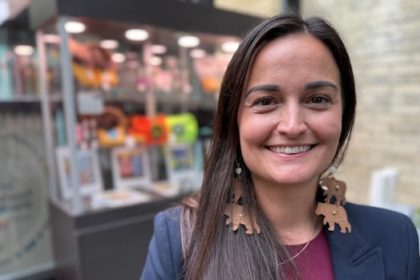The phrase “One pill can kill” is seen on almost every street you cross in the Mi’kmaq community of Listuguj in eastern Quebec. Next to the slogan is the image of Savannah Metallic, a community member who died on her eighteenth birthday in June of this year. The pill refers to fentanyl, a powerful synthetic opioid that is 50 times stronger than heroin. “She wanted to do so much with her life,” said her mother, Lacey Condo. She describes her as a sweet girl who always wanted to make people around her happy. But her last memories of Savannah are painful. “I had to go in there and see my daughter. Cold, stiff, blue lips, blue feet, foam coming out of her mouth, blood coming out of her nose,” she said. ‘If they would have just called 911, she would still be here,’ says Condo of the people who were with her daughter. Photo: Jeff Dorn/APTN. Lacey said she found Savannah the day after she overdosed. She said she wished the people who were by her side while she was overdosing did more to protect Savannah. “If they would have just called 911, she would still be here. She would be alive,” said Lacey. “She didn’t deserve that. She had so much to live for.” For Lacey, her daughter’s death represents a much greater issue – the prevalence of drugs and addiction in the community. “Nothing has been done as far as the drugs in our community,” she said. “They’re still selling the exact same pill that killed my daughter.” Accountability for dealers Savannah’s great aunt, Anita Metallic, wants accountability. This includes those who are making money off of selling drugs. “If you sold a pill to someone and they died, you need to be held accountable,” said Anita. She said at one point, she began receiving threats against her family after speaking out against drug dealers selling in Listuguj. She said she was told, “you better calm down cause they’ll go after your family,” which she added made it difficult to continue to speak out. Despite this, she’s still calling for dealers to be held accountable. APTN News spoke with various community members that refused to speak on record due to threat of retaliation. APTN also reached out to the Listuguj Mi’kmaq Government multiple times to understand how the council is addressing the issue. We did not receive a response to our request. “How many more people have to die? How many more children have to die?” said Anita. Opioid overdoses are a growing issue across Canada ‘No one knows how to deal with this,’ says Savannah’s aunt, Anita Metallic. Photo: Jeff Dorn/APTN. Listuguj isn’t the only community experiencing the loss of loved ones due to opioid overdoses. “Nobody knows how to deal with this, communities are struggling everywhere,” said Anita. She said the issue is seen in towns neighbouring Listuguj. “Campbellton, Cross-point – they’re dealing with it,” she said. Fatal opioid overdoses are occurring across Canada, with British Columbia and Ontario having the highest rates in the country. Last year alone, there were 7,245 fatal overdose deaths across the country. In the first three months of 2025, 1,377 fatal overdoses have occurred. APTN reached out to both Listuguj’s community social services directorate and the Listuguj police for statistics on how many opioid-related deaths are occurring in the community. Both departments said they do not carry this data. The tracking of First Nations opioid-related data is an issue across the country. Canada does not track opioid-related deaths in First Nations communities. In fact, the last statistics offered by Statistics Canada on First Nations opioid use is from seven years ago. Stats Canada published a report on the problematic use of opioid pain relief in 2018. It stated First Nations on reserves experience greater rates of opioid harms without providing specific numbers. A year earlier, in 2017, Health Canada published a report on the opioid crisis. Data collection from British Columbia and Alberta showed that First Nations people were three times more likely to die from an overdose. This data was only able to be published federally, as both provinces were tracking First Nations opioid overdoses at this time. Even just one death has such a dramatic impact on many lives. “There’s days where I can’t get out of bed. I can’t dedicate myself to anything,” said Lacey. It’s just been the hardest struggle I’ve ever endured.” Police say staff shortage hinders efforts in the fight against drugs Many community members APTN spoke with said the Listuguj police are not doing enough to crack down on dealers and protect the community from drugs. Just last year, the Listuguj Police moved to a new and improved building with more resources for officers. Despite the upgrade, the police said they struggle to address certain issues, including drugs in the community. They attribute this due to staff shortages. “I don’t know how many years that I can count on both hands, a steady decline in the production of police officers,” Sharon Barnaby, interim chief of the Listuguj Police told APTN. She said there are a lot more retirements than hirings. Tyler MacDonald, a criminal investigator for the Listuguj Police, said another issue the police experience is dealing with multiple jurisdictions and borders. He said there are three police jurisdictions within a very small area. “We have the RCMP that look after Campbellton, we have the [Sûreté du Québec] that look after the area around us,” he said. “And then we have us in the territory here.” The Sûreté du Québec is the province’s provincial police force, commonly known as the SQ. MacDonald said this can create difficulties when drug investigations cross over into other jurisdictions. He said one way the police have responded to drugs in the community is providing an anonymous tip line which started last year. But, he added, information received from the tip line can’t always be used. “We have to corroborate the information,” he said. MacDonald said in cases where information is provided by only one source instead of multiple sources, the police do not use the information in order to protect the source. “The information can’t be pointing or revealing for their safety, which is one of the reasons why they went anonymous in the first place,” said Barnaby. “Anonymous information also means that we have to be the ones who validate it.” The police said they need the community’s trust through the tip line to be able to continue to crack down on drugs. MacDonald said all the drug files fall under his responsibility, calling it “challenging.” Part of the challenge comes from how dealers respond to the police. “What we reveal, they learn, adapt, and change,” said Barnaby. “So we have to do the same. We have to get fancier tools and more eyes on the road.” Breaking the cycle of addiction ‘To me, I feel like it’s up to you to break the cycle,” says Celeste Barnaby. Photo: Jeff Dorn/APTN. Celeste Barnaby is a recovering addict of 11 years, going on 12. Her journey isn’t the only time she’s been impacted by substance abuse. Celeste has also experienced addiction around her. “My mom, she’s an addict and my dad was an alcoholic,” she said. Now photos commemorating her father and others she’s lost to addiction hang on her fridge – including a photo of Savannah. She said it was difficult seeing both her daughters hurt by Savannah’s death. Celeste’s oldest daughter was childhood friends with Savannah. She said Savannah visited her home frequently and wished she could have been there for Savannah – or – that Savannah would have reached out to her for help. “She didn’t even get to live her life,” she said. “I couldn’t imagine losing my daughter at that age, I would lose my mind.” For Celeste, part of reducing addiction requires breaking the cycle. Part of the way she does this is by having conversations with her children about the harms of drugs and her own experience with addiction. Celeste said she had this conversation with her oldest daughter after she turned 12. She said her youngest daughter is turning 12 soon, and she’ll be sharing her experience with addiction after her birthday. APTN asked Celeste if her daughter’s school Sugarloaf Senior High School, the same school Savannah attended, provided information on addiction and substance abuse. She said she didn’t know. APTN spoke with one student who said Sugarloaf Senior High School did not provide any education or awareness on drug use and only spoke out against the use of vaping on school grounds. APTN is not naming the student. We reached out to guidance councillors at the school on whether the school provides education on addiction. We did not receive a response before our deadline. “To me, I feel like it’s up to you to break the cycle,” said Celeste. “If you want the help, you’ll get the help. There’s so many resources out here that we have in our community.” Resources for those experiencing addiction in Listuguj Lacey Condo, seen here speaking with APTN correspondent Savanna Craig, says having drugs on the streets is painful. Photo: Jeff Dorn/APTN. “They’re taking that alcohol and they’re taking that drug, so they’re not feeling the pain,” said Michael Martin, Knowledge Keeper and addiction counselor at the Listuguj Community Social Services Directorate. “We always go back to the core of our addictions. It’s not stemmed from alcohol or drugs. It stemmed from historical trauma,” he said. Martin said reducing overdoses in Listuguj requires healing from trauma. Despite the services offered, he said not all departments work together in a coordinated way to address overdoses and drugs in the community. “The people that are above me, and maybe the political realm, that they have things to do, and it takes time for them, and for myself, I’m patient with that,” he said. He said he won’t recommend the police or councillors what to do unless he’s invited to the table. Some said these departments used to work together, including Mi’kmaq Hereditary Chief Gary Metallic. He said he was an addictions councillor in the ‘80s. “When we were part of the alcohol and drug program, we had a networking system of the police, chief and council,” he said, adding that all the social services would meet once a week to discuss issues in the community. “I think that’s got to be brought back,” Gary said. Martin said he looks ahead to the spring, when the services that are offered by the Listuguj Community Social Services Directorate will expand. He said these services will be rooted in tradition, including sweat lodges, drying of meat, making regalia and rattles. While community members have to wait until next spring for these services, a new centre was launched in Listuguj early October. The Mawiomi Treatment Centre is a non-profit treatment centre for Indigenous people affected by substance abuse. The treatment centre has been up and running in Gesgapegiag, Gaspésie, Québec since 2020. But now a second centre is available in Listuguj. Despite new and upcoming resources, many community members still grapple with the loss of loved ones, as drugs continue to flow on the streets of Listuguj. “[These drugs] are still on our streets, it’s just painful to watch,” said Lacey. “It’s like a slap in the face every single day.” Continue Reading
Listuguj mourns loss of 18-year-old girl, wants accountability for opioid-related deaths

Leave a Comment










